HOME
KOREA
- images from KYERYONGSAN
-
featuring
the Tonghaksa- and Kapsa
Temple
The name, - Kyeryongsan -, means something
like "Rooster-Dragon-Mountain" because the ridge, - seen from a distance
-, really does looks as the back of a dragon with a roosters head.
The ridge consists of 16 peaks, of which
the highest is Chonhwangbong of 845 meters.
Of Koreas many magnificent National Parks,
I do not consider Kyeryongsan to be particular scenic compared to what
Korea otherwise has to offer when it comes to spectacular scenery.
However,- the Kyeryongsan area do have several
unique cultural and historical sites spread over the valleys and mountain
slopes, - like famous temples Kapsa and Tonghaksa -, and it is indeed a
pleasure to hike the many mountain trails along crystal clear streams,
vertical walls and several waterfalls.
Therefore, - if you are in the neighborhood,
- and if you have time -, it is very much recommended to stop for a couple
of days at this place and take some hikes through the valleys, climb a
few peaks, - eventually cross the mountain range from one side to the other-,
and pay a visit to some of the temples and other cultural and historical
sites on this magnificent mountain.
Here are some of my impressions from a visit
to Kyeryongsan mountain way back in August 1997, when I happened to pass
through, - and decided to stay for a while - - -
Please enjoy - - - :-)
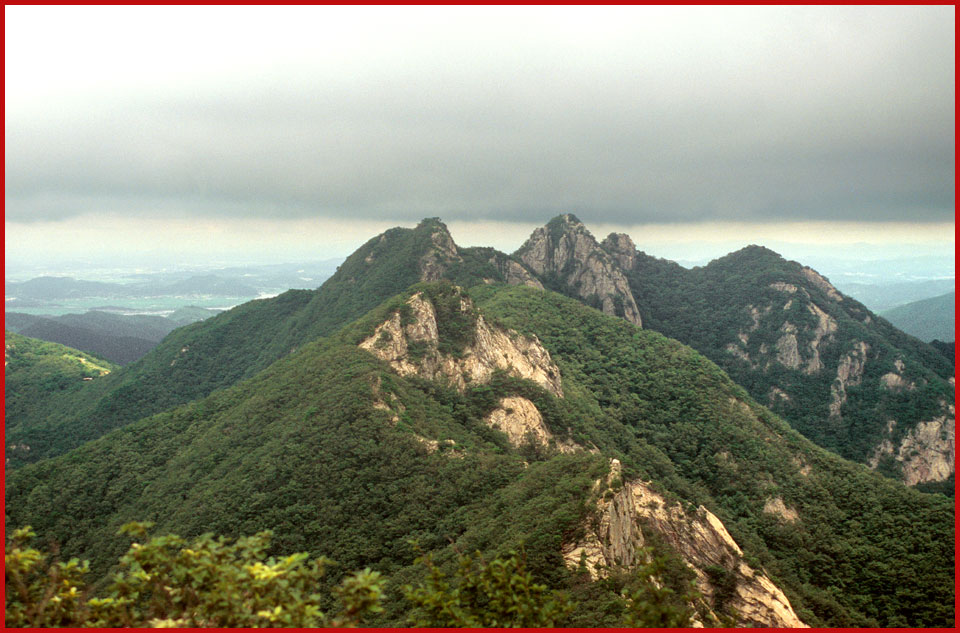
Kyeryongsan
View of the Kyeryongsan ridge,-
as seen from Kwanumbong (816 m)
(Photography by Karsten Petersen)
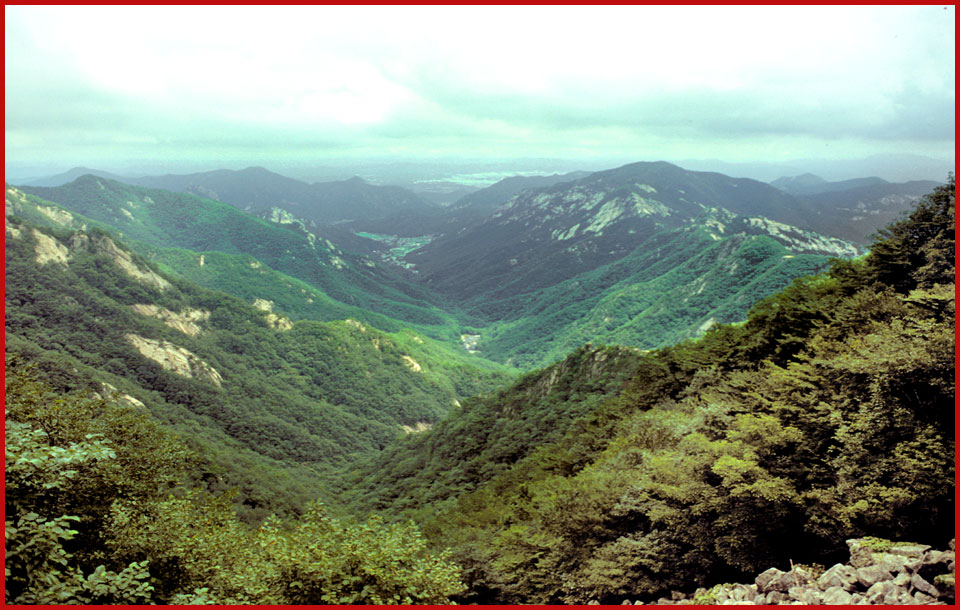
Kyeryongsan
- a view into the Tonghaksa
Valley, - again seen from Kwanumbong Peak -
(Photography by Karsten Petersen)
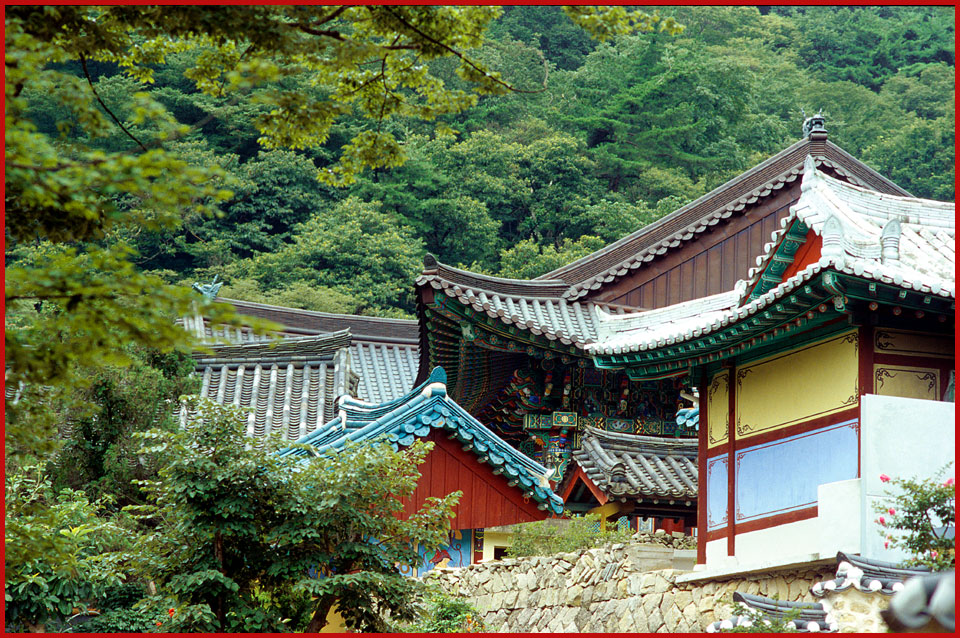
Kyeryongsan
- the Mita-am temple complex,-
on the trail up the Tonghaksa Valley -
(Photography by Karsten Petersen)
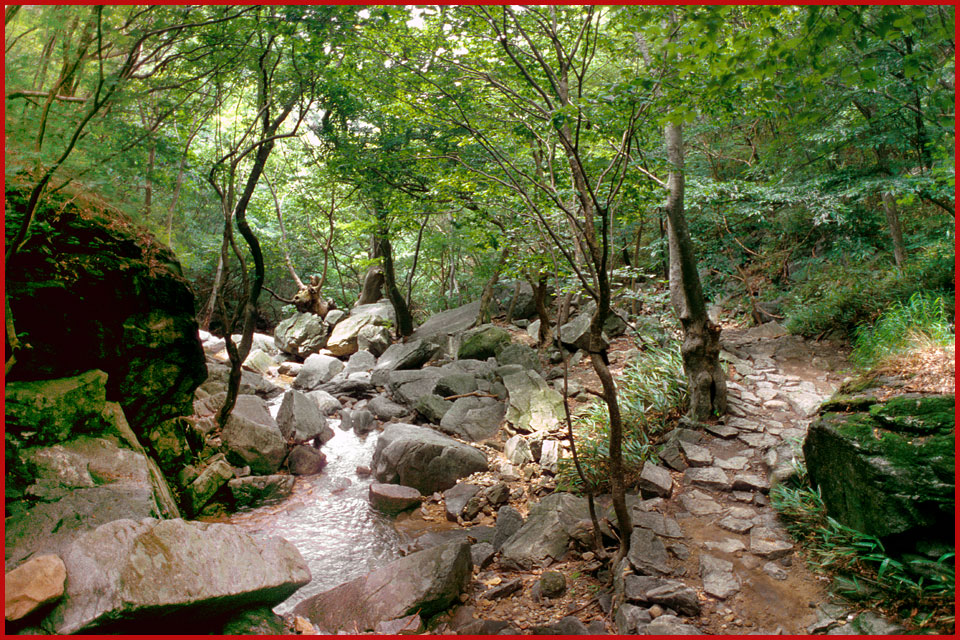
Kyeryongsan
- on the trail -
(Photography by Karsten Petersen)

Kyeryongsan
Nammaetap- or "Brother and
Sister" Pagodas.
(Photography by Karsten Petersen)
Along the trail up to the Kumjandi Pass, -
and near the top of Pirobong Peak-, you will find these two pagodas from
the Shilla Dynasty, although they are built in typical Paekche style. They
are the Nammaetap pagodas-, or "Brother and Sister" pagodas.
There is a good story behind these pagodas.
They were built in memory of the Buddhist
monk Sangweon, who lived a simple life on the Pirobong mountain, where
he spent his his time meditating and studying the Buddhist scriptures.
One winter day a friendly tiger, - who obviously
felt pity with him -, came to his cave, carrying on his back a young girl
from the village in the valley, deep below the mountain.
Being a monk, Sangweon did not want to have
a wife, but since the snow and ice on the mountain prevented all attempts
to take her back to her village, she was forced to stay in his cave all
winter.
During that long and cold winter, they lived
together without touching each other, and soon she became very impressed
by the wisdom and insight of Sangweon, who spent the time teaching her
Buddhism and meditation, and when spring time finally came to the mountain,
she did not want to go back to her village again.
Therefore they continued to live together,
and eventually they both became well known scholars of the Buddhist teachings,
and they stayed together for the rest of their lives, - like a brother
and sister - - -
When they died, they were so highly respected
for their wisdom and insight into to "how things are", that two pagodas
were built to their honour,- and those two pagodas can be seen on the mountain
to this very day near the place where they lived their simple lives in
peace and harmony with nature, and in isolation from the greed, desire
and corruption of the "outside" world - - - -
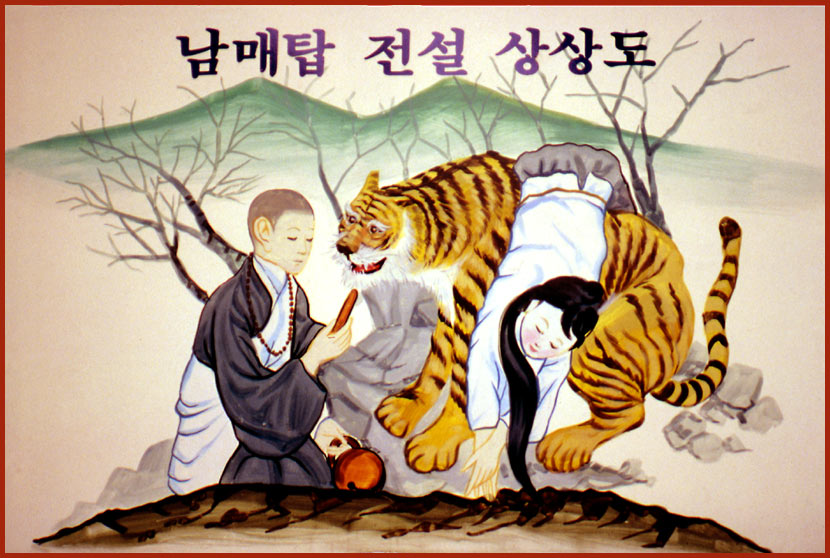
Here a wonderful painting of
the tiger bringing his "gift" to Sangweon - -
(Photography by Karsten Petersen)
Today there are still Buddhist monks on the
Pirobong mountain. Just besides the "Brother and Sister" pagodas
there is a hermitage called Cheongryang-am.
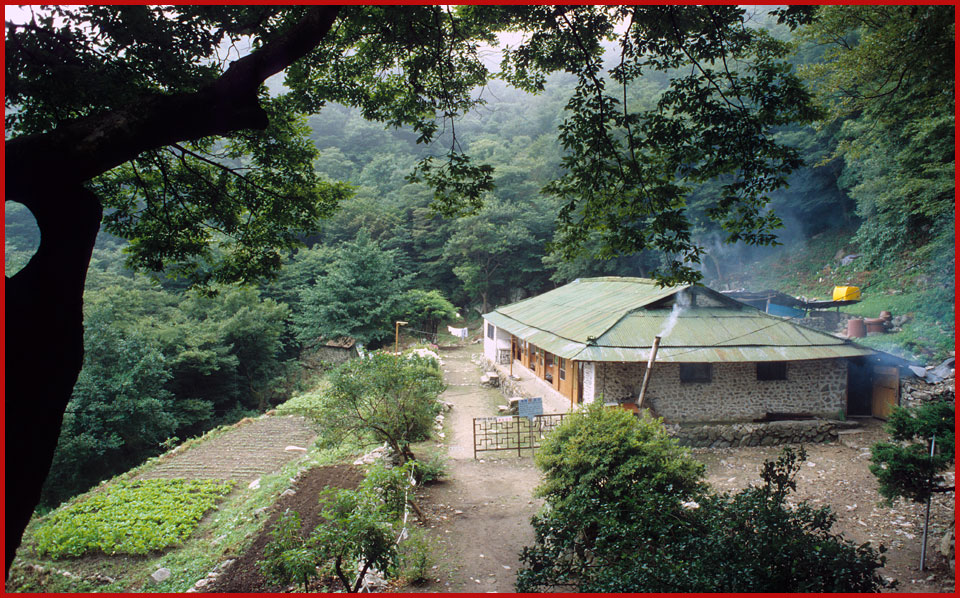
Kyeryongsan
- here the hermitage Cheongryang-am
-
- looks more like a farm house,
- but it is actually a Buddhist hermitage -
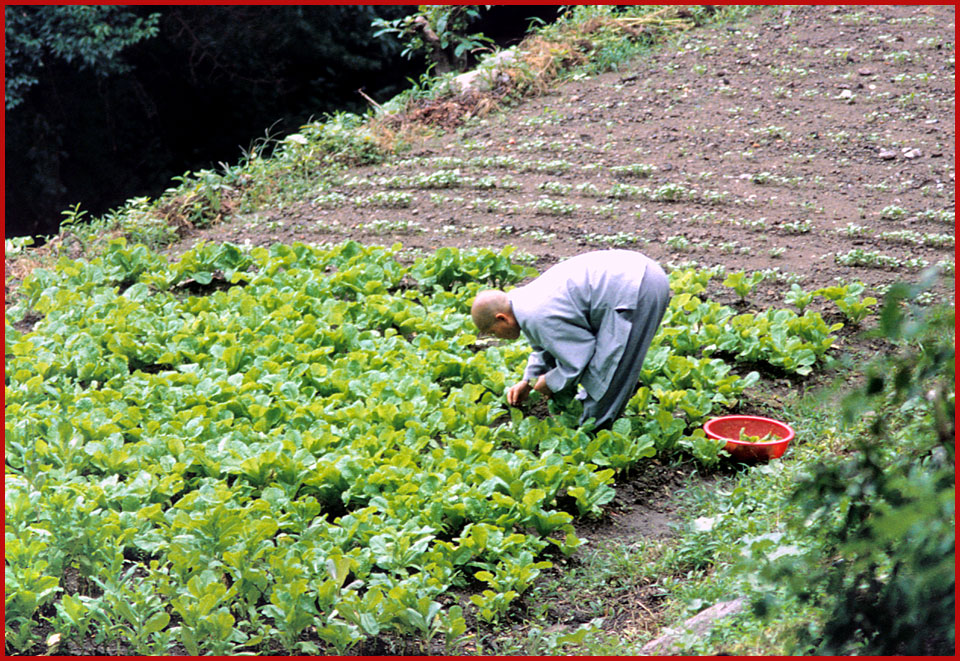
Kyeryongsan
- and if you are ,lucky, you
can see the lonely monk tending his vegetable garden -
(Photography by Karsten Petersen)
Shortly after the Cheongryang-am hermitage
and the Nammaetap pagodas you reach the Kumjandi Pass, and from here the
trail goes downwards to the very old Kapsa temple.
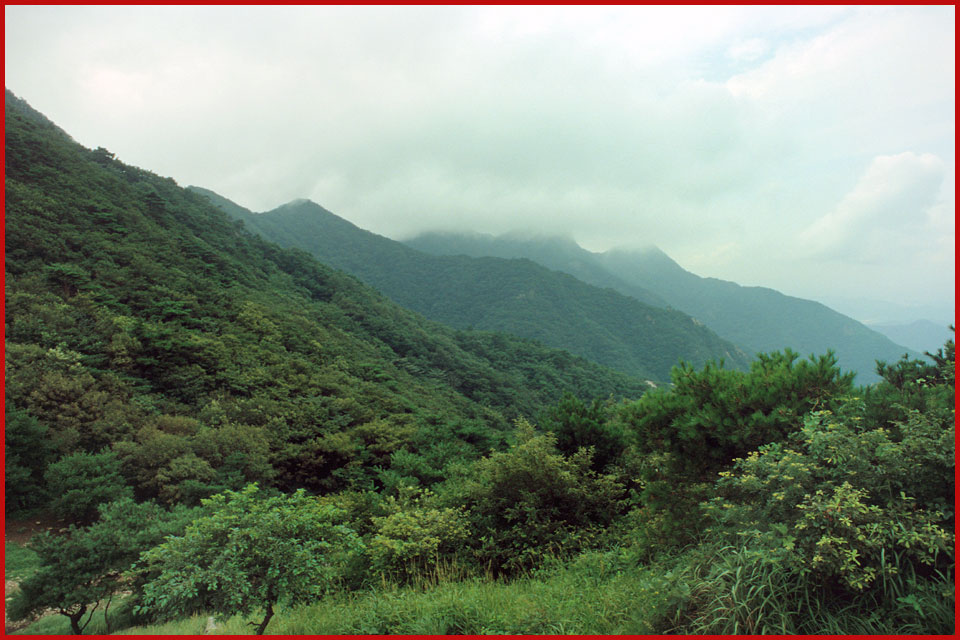
Kyeryongsan
- the the Kunjandi Pass -
(Photography by Karsten Petersen)
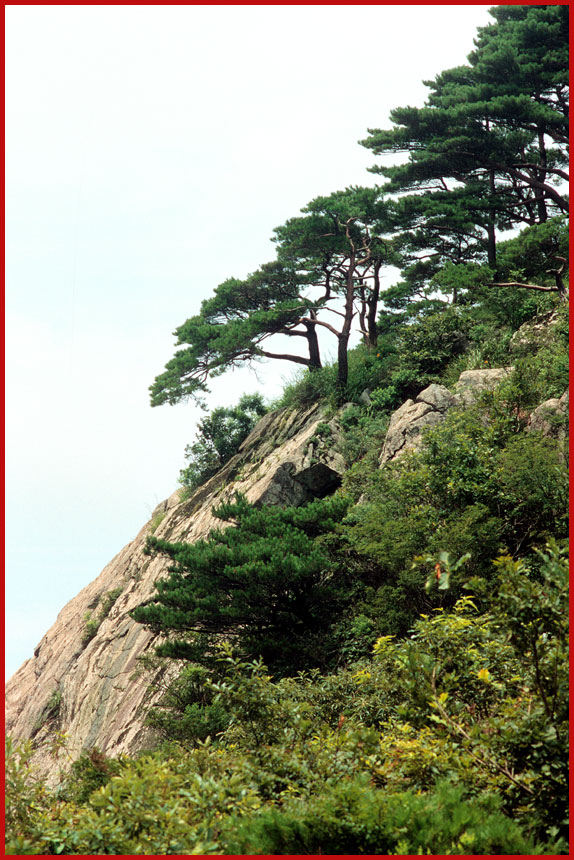
Kyeryongsan
- one of the rocky walls of
the Kumjandi Pass -
(Photography by Karsten Petersen
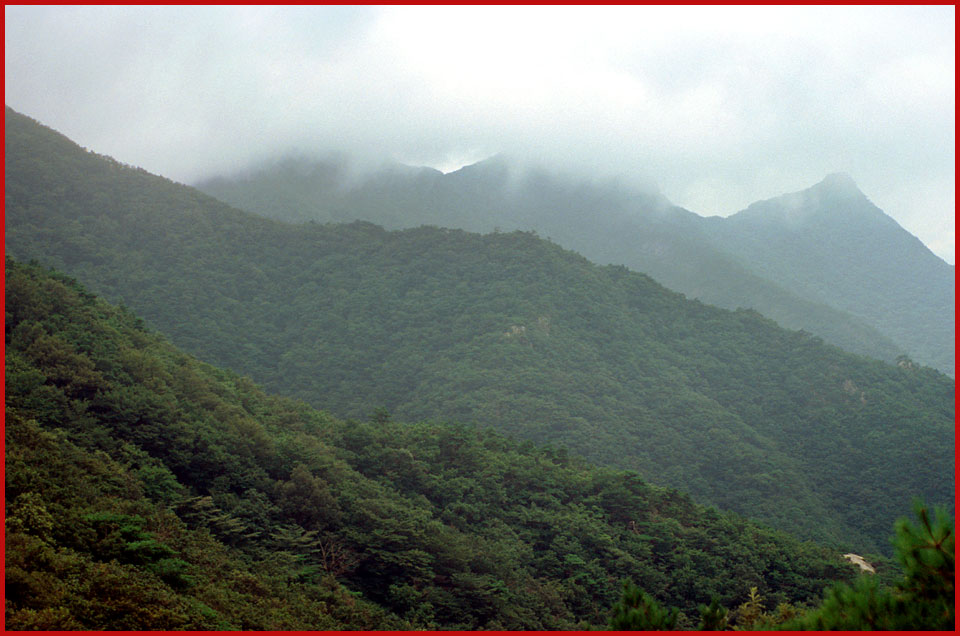
Kyeryongsan
- view from the Kumjandi Pass
-
(Photography by Karsten Petersen)
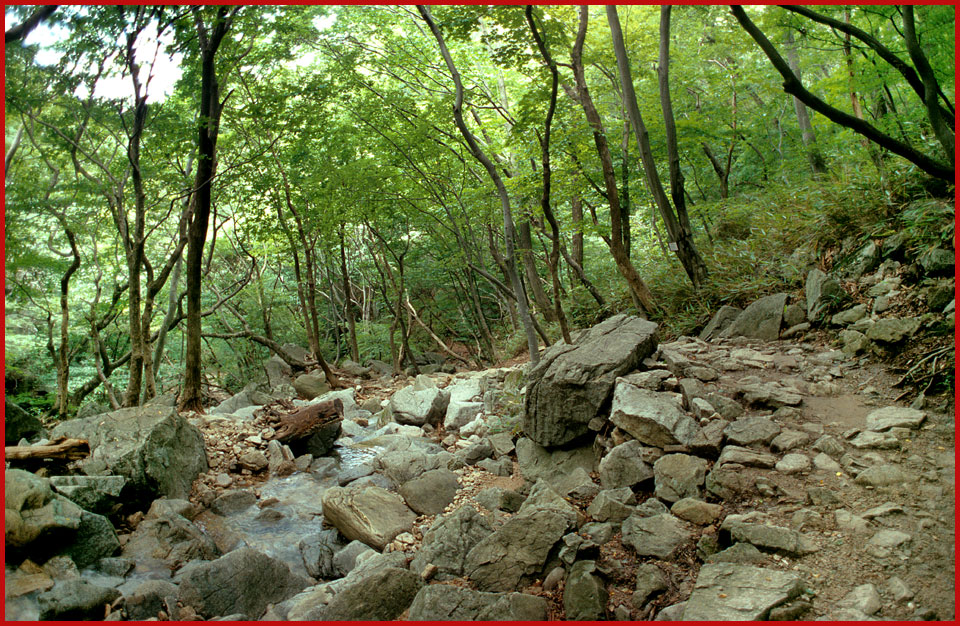
Kyeryongsan
- the trail to the valley below and the Kapsa
temple -
(Photography by Karsten Petersen)
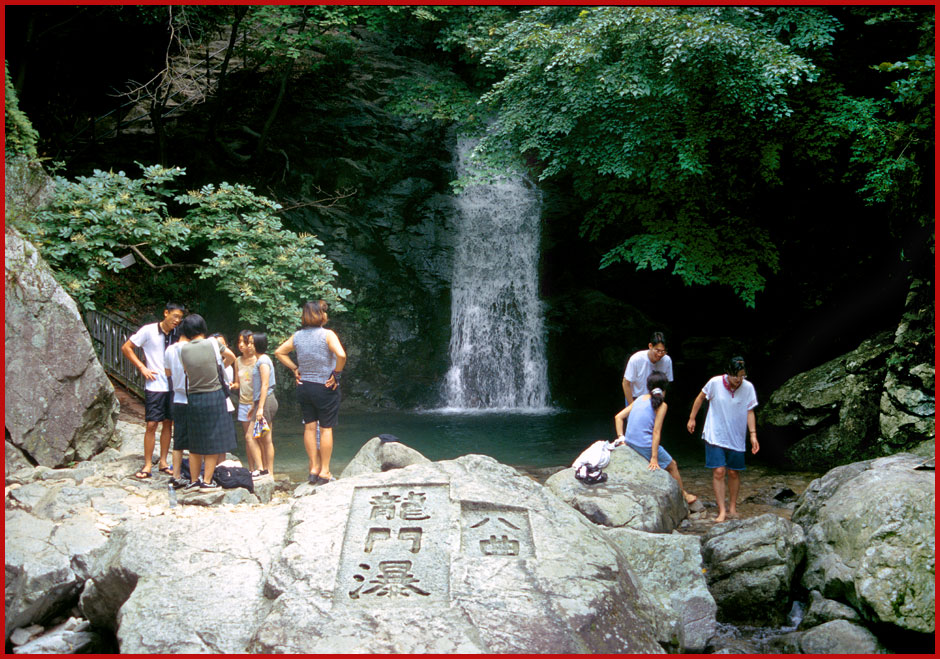
Kyeryongsan
On trail down from the Kumjandi
Pass towards the Kapsa Temple, you pass the Yongmun waterfall - -
(Photography by Karsten Petersen)

Kyeryongsan
The Yongmun falls are by no
means big or impressive, but it is a very lovely spot, - and as you can
see on this picture -, it is also a great place for a meditative moment
in harmony with the universe -
(Photography by Karsten Petersen)
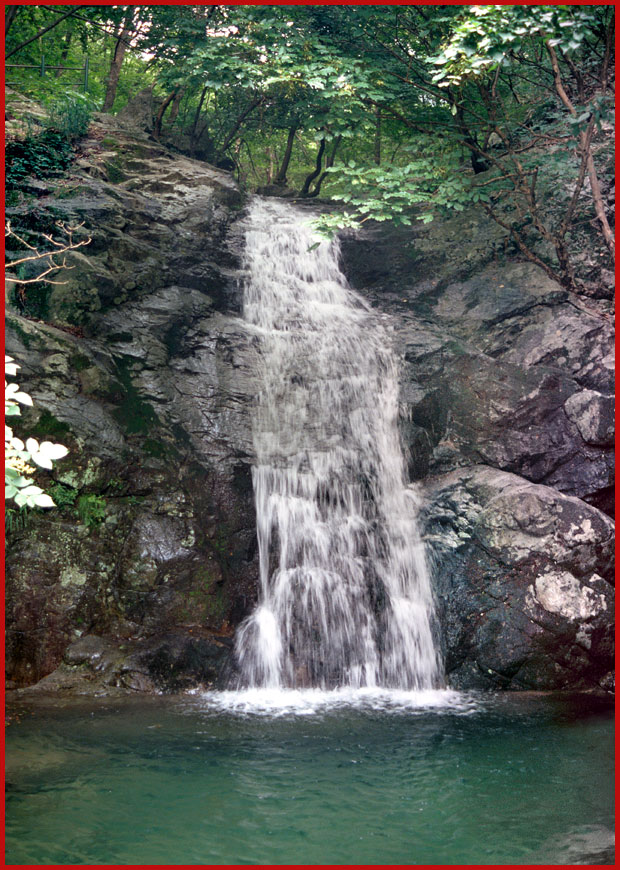
Kyeryongsan
- a final view of the lovely
Yongmun falls -
(Photography by Karsten Petersen)
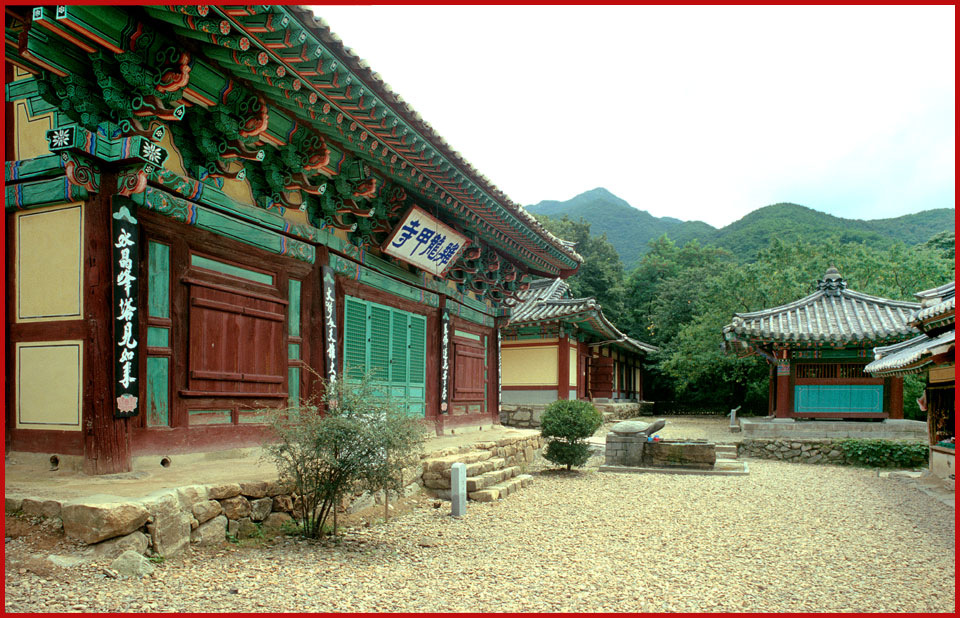
Kyeryongsan
At the end of the trail you
are rewarded with the very old Kapsa temple - -
(Photography by Karsten Petersen)
The Kapsa Temple dates back to the Shilla
period and as such it could well be over 1000 years old. That does not
make Kapsa the oldest temple in Korea, since the oldest one is the Shinhung-sa
built in year 652, which makes Shinhung-sa not only the oldest Zen Buddhist
temple in Korea, but in the whole World.
Not even in China they have anything that
can match it, but the problem is, - like with so many other temples-, that
no or very little structures are left from the original construction.
But not so with the Kapsa temple!
At the Kapsa, some of the buildings are supposed
to be the real thing!

Kyeryongsan
- the very old Kapsa temple
-
(Photography by Karsten Petersen)
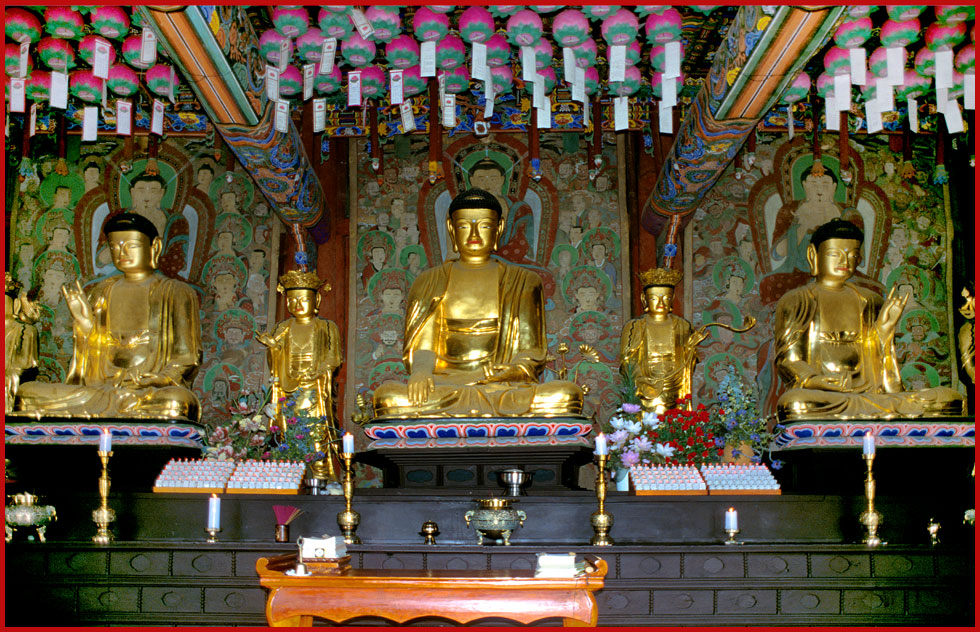
Kyeryongsan
- inside one of the halls of
the Kapsa temple -
(Photography by Karsten Petersen)
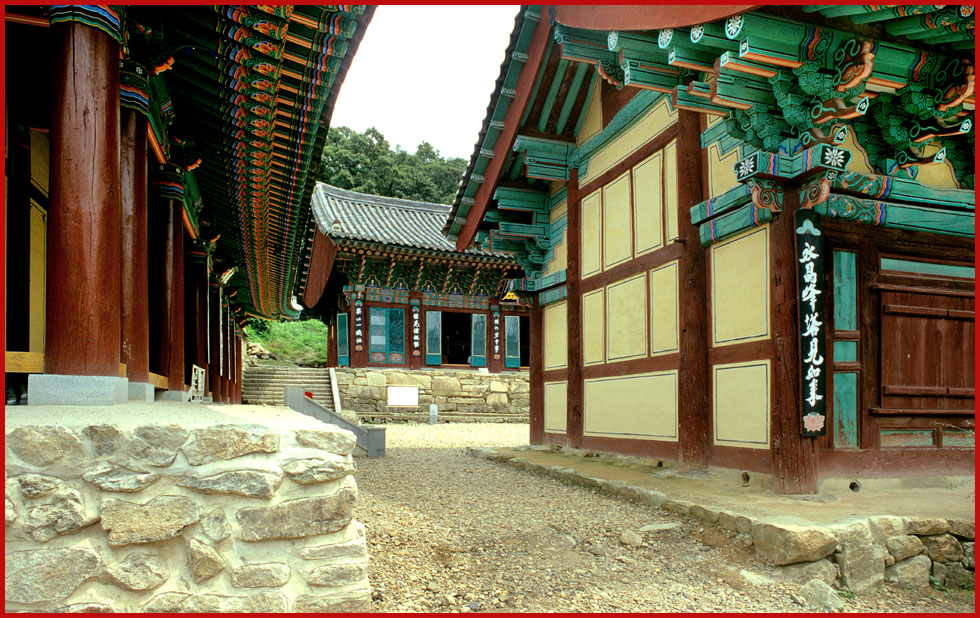
Kyeryongsan
- departing from the Kapsa
temple -
(Photography by Karsten Petersen)
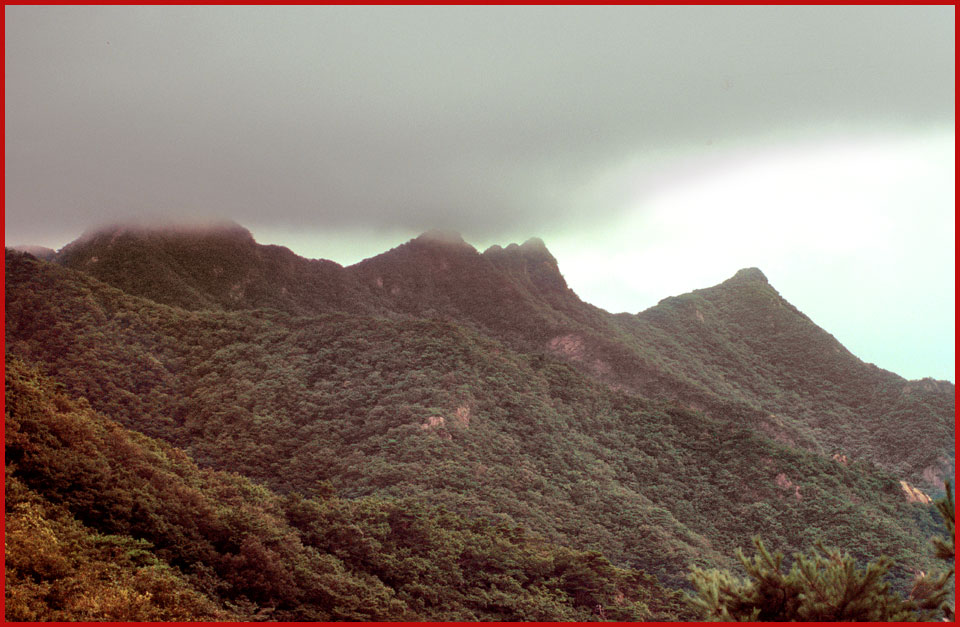
Kyeryongsan
- up on the Kyeryong mountain
ridge again via the Kumjandi Pass -
(Photography by Karsten Petersen)

Kyeryongsan
- more from the top of Kwanungbong,
- and hikers enjoying the view towards the valley below -
(Photography by Karsten Petersen)
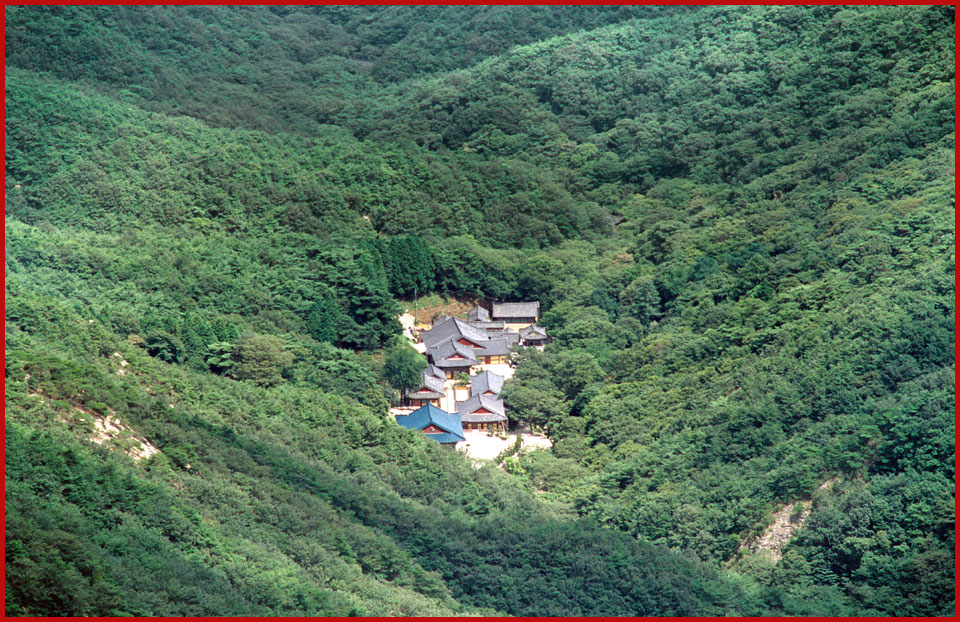
Kyeryongsan
- a view of the Tonghaksa temple
deep down in the valley below -
(Photography by Karsten Petersen)

Kyeryongsan
- the impressive great hall
of the Tonghaksa temple -
(Photography by Karsten Petersen)
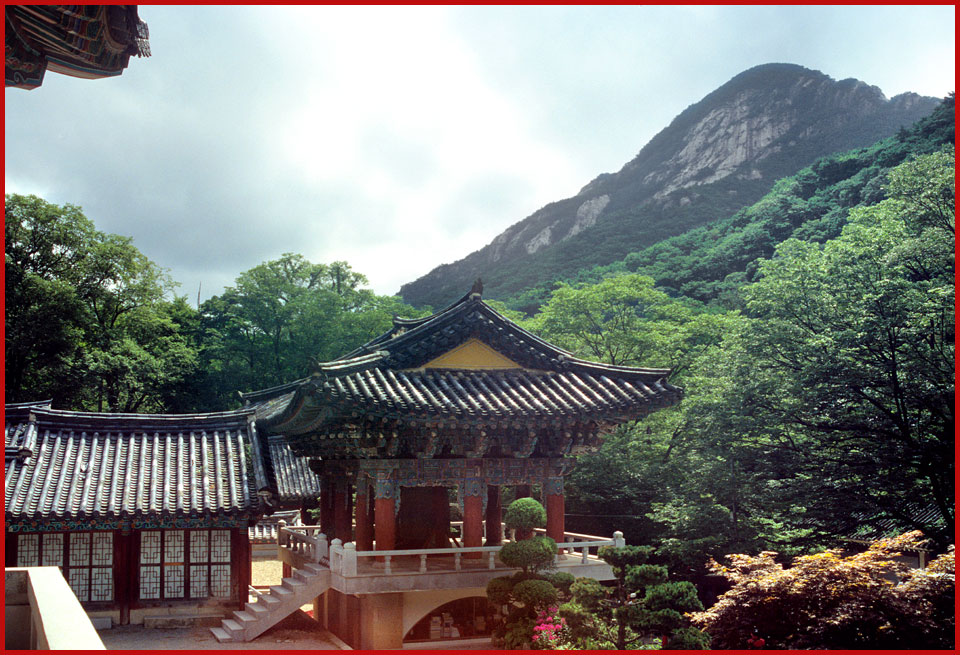
Kyeryongsan
- the bell tower of the Tonghaksa
temple -
(Photography by Karsten Petersen)
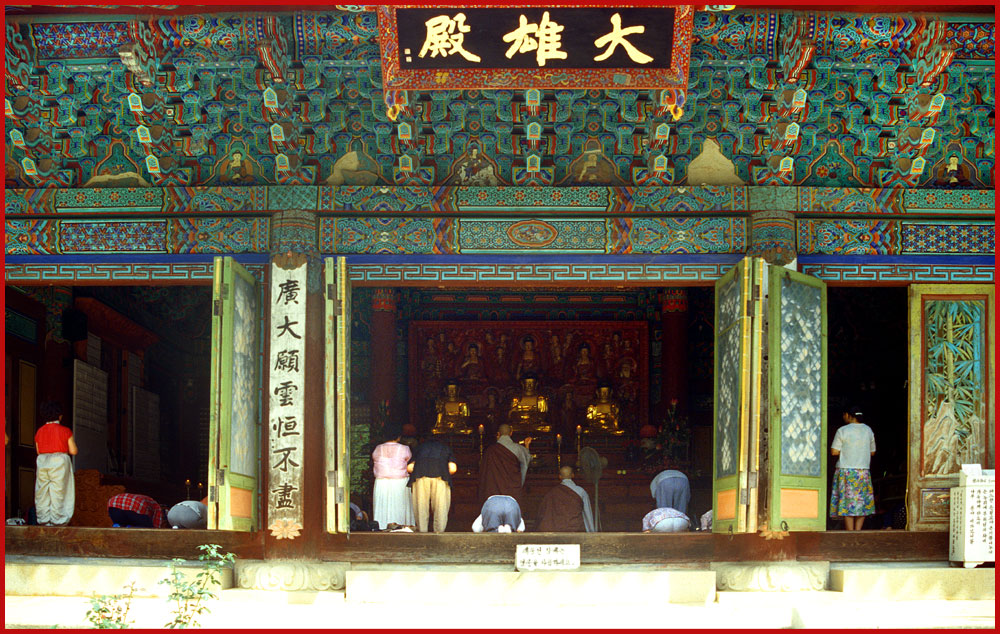
Kyeryongsan
- the great hall of the
Tonghaksa Temple -
(Photography by Karsten Petersen)
In spite of its beauty, harmony
and great setting, the Tonghaksa is not a very old temple since it has
been destroyed and rebuilt several times, - last time in 1953, after it
was destroyed during the Korean War.
However, - still it dates back
to year 724, and today it is one of the very few temples in Korea where
female monks are trained in Buddha's teachings, and it is truly wonderful
to hear 150 voices chanting the mantras in the quiet valley - -
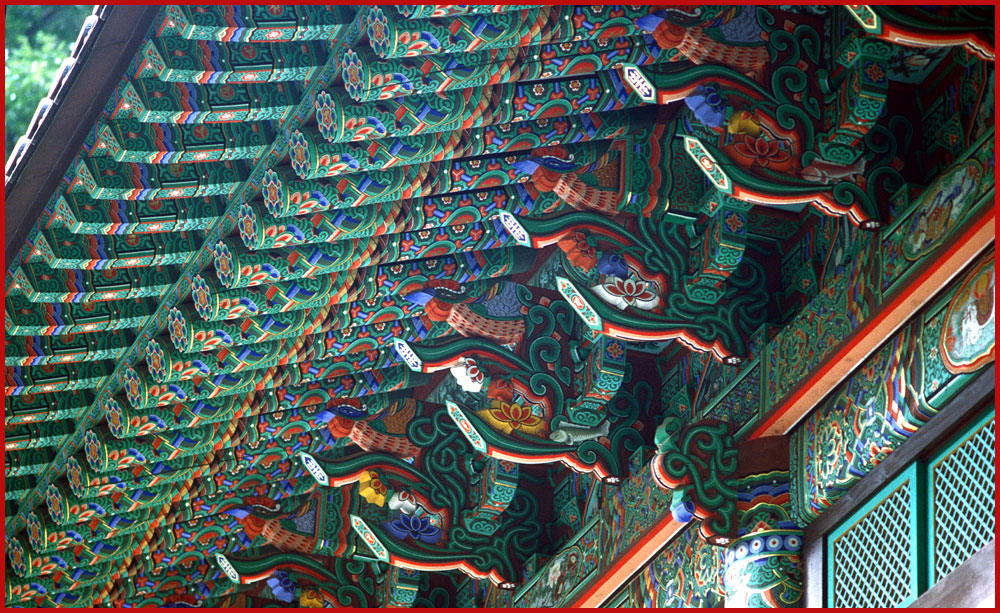
Kyeryongsan
- an excellent example of "Dan
Chung" paint work on the Tonghaksa Temple -
(Photography by Karsten Petersen)
Dan Chung painting is an old Buddhist art
based on the Yin Yang "Theory of Five".
According to this theory, the World are made
from 5 elements, - wood, fire, earth, gold and water.
These 5 elements each have a colour attached
the them, as well as a direction in the universe.
They are:
Wood = Green = East, Fire = Red = South,
Earth = Yellow = Center, Gold = White = West, and Water = black
= North.
Therefore, - when painting the temple woodwork,
only these 5 colours are used, - and no others - - -
In that way, Dan Chung painting serves two
purposes, - one being the purely symbolic, - and the other one is simply
for protection of the wood structure.

Kyeryongsan
- let's finish with a shoot
of a vertical wall, where trees seem to grow directly from the rock surface
-
(Photography by Karsten Petersen)
Back to "Korea"
Back to "Places"
Updated:
June 22nd. 2003
Dec. 30th. 2004
July 5th. 2006
March 2.2008


























